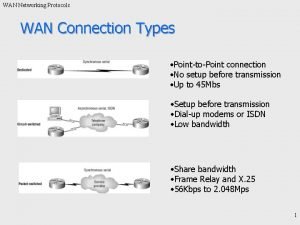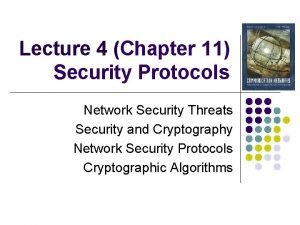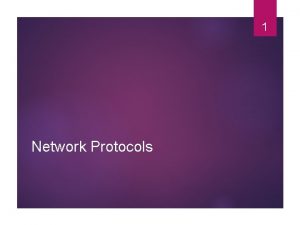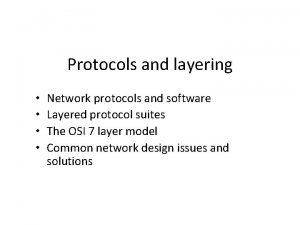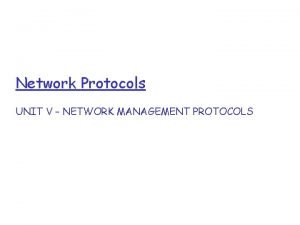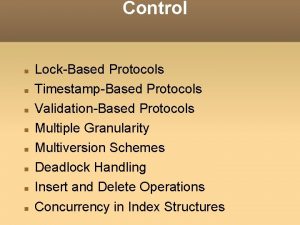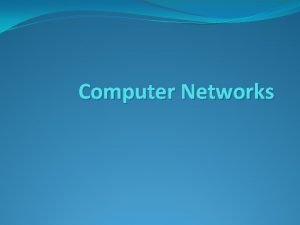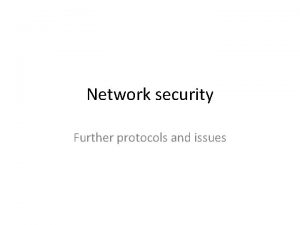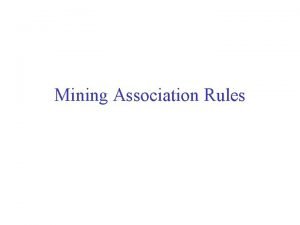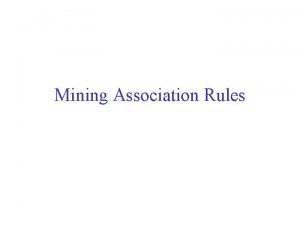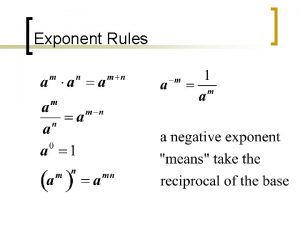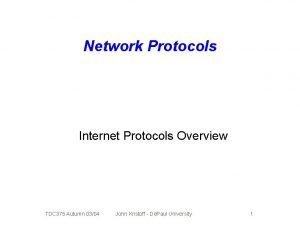Protocols and Network Software Protocols are rules for




















- Slides: 20

Protocols and Network Software

Protocols are rules for communication. Tasks: • Define how to interpret signals • Identify individual computers • Initiate and end networked communication • Manage information exchange across network medium • Determine the type of error checking to be use

Protocols -cont • A combination of protocols is called a protocol stack or protocol suite. • Types of protocols: – A connectionless protocol treats each packet independently , the packets may or may not travel to the same destination. – A connection-oriented protocol the source first makes a connection with the destination before sending packets , when the connection is established , a sequence of packets can be sent.

Introduction to TCP/IP TCP and IP were developed by a Department of Defense (DOD) research project to connect a number different networks designed by different vendors into a network of networks (the "Internet"). It was initially successful because it delivered a few basic services that everyone needs (file transfer, electronic mail, remote logon) across a very large number of client and server systems.

TCP/IP • Transmission Control Protocol /Internet Protocol (TCP/IP) • It is the most common protocol suite used today for LANs as well as the Internet. • It is composed of several different protocols. IP DNS FTP Telnet RIP NNTP ARP whois IGMP SMTP TFTP TCP/IP protocol suite OSPF UDP RARP TCP SNMP NTP and many more. . . BOOTP finger ICMP

TCP/IP X X Application Protocols Transport Protocols Internet Protocols Network Interface Protocols

1 - Application Protocols • Protocols : – Telnet – FTP : (File Transfer Protocol)-an internet file transfer protocol. – TFTP – SMTP : (Simple Mail Transfer Protocol )-an internet protocol for transferring e-mail. – LPD – NFS – SNMP: (Simple Network Management Protocol)-an internet protocol for monitoring networks and its components – X WINDOWS

2 -Transport Protocols • Protocols: • TCP • UDP • DNS

2 -Transport Protocols 1. Transmission Control Protocol (TCP) • • TCP is a connection-oriented transport protocol that sends data as an unstructured stream of bytes. TCP is responsible for the reliable transmission of data from one host to another (acknowledgment). TCP can also recognize duplicate messages and will discard them appropriately. If the sending computer is transmitting too fast for the receiving computer, TCP can employ flow control mechanisms to slow data transfer.

2 -Transport Protocols 2. User Datagram Protocol (UDP) • It is connectionless and it is very simple protocol • Provides fast delivery of data but does not guarantee data reliability.

3 - Internet Protocols (network layer ) Responsible for addressing , packaging and routing the data to be transmitted , it contains the following protocols: • Internet Protocol (IP) Responsible for addressing the data to be transmitted and getting it to its destination. • Address Resolution Protocol ( ARP) Responsible for identifying the media access control address (MAC) of the next hop. • Internet Control Message Protocol (ICMP) Responsible for providing diagnostic functions and reporting errors due to unsuccessful delivery of data. • Internet Group Management Protocol (IGMP) Responsible for the management of multicasting with TCP/IP

4 - Network Interface protocol • • Responsible for placing data on the network medium and receiving data off the network medium. Contains : • • • Network Cables Network Adapters: has (MAC) It does not contain any software-based protocol, but it contains protocols that defines how data is transmitted on the networks.

IP Addressing • The hosts on a TCP/IP network use a logical address. • This logical address, called the IP address and it assigned to each host. • IP is responsible for the addressing of packets.

IP Addressing • Is responsible for moving packet of data from node to node. • IP forwards each packet based on a four byte destination address (the IP number). • The Internet authorities assign ranges of numbers to different organizations. The organizations assign groups of their numbers to departments. IP operates on gateway machines that move data from department to organization to region and then around the world.

IPv 4 Addresses • An IP address is a 32 -bit sequence of 1 s and 0 s • Every IP address has two parts – The network portion – The host portion • An IP address is an hierarchical address • IP addresses are divided into classes to define the large, medium, and small networks – Class A – Class B – Class C

Internet Protocol (IP) • It’s Job: get some data – from source IP address – to destination IP address Data destination: 196. 57. 3. 201 source: 140. 117. 34. 7 Data = hosts/routers on a network

IP Addressing • An IP address is four bytes (octets). Each contains eight bits (total of 32 bits in length). • Each octet is a number from 1 to 254. • IP addresses are usually given as dotted decimal notation EX: 196. 57. 3. 201

IP Classes of Addresses

Private Addresses • Internet requires translation of the private addresses to public addresses. • This translation process is referred to as Network Address Translation (NAT)

IPv 4 and IPv 6 • IPv 6 uses 128 bits rather than the 32 bits • Provides 640 sextrillion addresses • IPv 6 addresses are 128 bits long, written in hexadecimal form, and separated by colons.
 Antigentest åre
Antigentest åre Network topologies and protocols
Network topologies and protocols Chapter 3 network protocols and communications
Chapter 3 network protocols and communications Types of wan
Types of wan Network security protocols
Network security protocols Network security protocols
Network security protocols Wireless sensor network protocols
Wireless sensor network protocols Network communication protocols map
Network communication protocols map Iso 22301 utbildning
Iso 22301 utbildning Typiska novell drag
Typiska novell drag Nationell inriktning för artificiell intelligens
Nationell inriktning för artificiell intelligens Returpilarna
Returpilarna Shingelfrisyren
Shingelfrisyren En lathund för arbete med kontinuitetshantering
En lathund för arbete med kontinuitetshantering Adressändring ideell förening
Adressändring ideell förening Tidbok yrkesförare
Tidbok yrkesförare Sura för anatom
Sura för anatom Vad är densitet
Vad är densitet Datorkunskap för nybörjare
Datorkunskap för nybörjare Boverket ka
Boverket ka Debattartikel struktur
Debattartikel struktur



